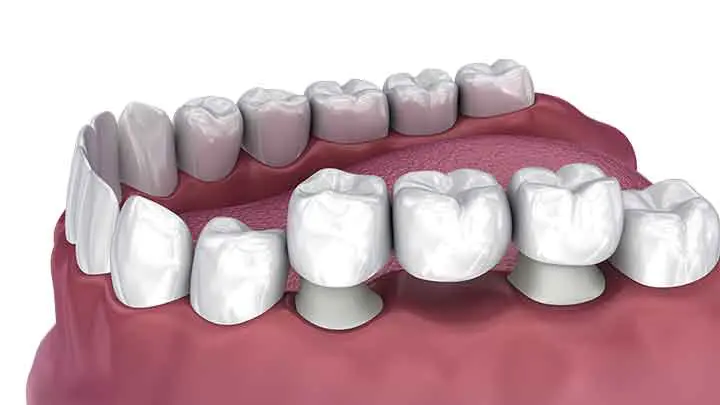Dental bridges offer a timeless solution to missing teeth, seamlessly bridging the gap where one or more teeth used to be. This buyer’s guide, crafted explicitly for Palmetto Family and Cosmetic Dentistry patients, is designed to walk you through the essential aspects of dental bridges, helping you make an informed decision that aligns with your dental health goals, lifestyle, and budget.
Dental bridges are prosthetic devices anchored on existing teeth or implants to replace one or more missing teeth. By filling the gap left by missing teeth, bridges restore the aesthetics of your smile and prevent the remaining teeth from shifting, which could lead to bite issues or jaw pain.
Bridges can be made from various materials, including porcelain, ceramics, gold, or metal alloys, offering functional and aesthetic benefits.
The Importance of Replacing Missing Teeth
Missing teeth can lead to a host of dental problems, including:
- Shifting of Adjacent Teeth: This can cause misalignment and affect your bite.
- Jawbone Loss: The absence of tooth roots leads to jawbone deterioration.
- Difficulty Chewing and Speaking: Missing teeth can impair your ability to chew correctly and affect speech.
- Self-Esteem Issues: Gaps in your smile can impact your confidence and willingness to smile.
Types of Dental Bridges
There are four primary types of dental bridges, each suitable for different situations:
- Traditional Bridges: The most common type involving one or more fake teeth held in place by dental crowns cemented onto the adjacent teeth.
- Cantilever Bridges: Similar to traditional bridges, the pontic (artificial tooth) is supported by a crown on only one side rather than both. It is suitable when teeth are in one area around the tooth or teeth that are missing.
- Maryland Bridges: These bridges consist of a pontic held in place by a metal or porcelain framework bonded onto the backs of the adjacent enamel, keeping more of the tooth’s original structure.
- Implant-Supported Bridges: The most stable and durable option, dental implants support these bridges instead of using crowns or frames. Suitable for those missing several teeth in a row.
Choosing the Right Type of Bridge
Choosing the correct type of dental bridge is crucial in restoring the functionality of your teeth and your confidence in your smile. Dental bridges are made to “bridge” the space of a missing tooth. They are anchored on either side by your natural teeth or by dental implants. There are mainly four types of bridges:
- Traditional Bridges: Ideal for those with natural teeth on each side of the space where the tooth is absent. These bridges involve creating a crown for the teeth on either side of the gap with a pontic, or replacement tooth, in between.
- Cantilever Bridges: Similar to traditional bridges, the pontic is supported by a crown on only one side instead of both. This option is suitable when teeth are on only one side of the lost tooth or teeth.
- Maryland Bridges: These bridges use structural support attached to the undersides of the adjacent teeth. Because crowns do not anchor this type of bridge, it is less invasive but may not be as strong as the traditional type.
- Implant-Supported Bridges: Best for when multiple teeth are not present. Dental implants hold these bridges in place instead of traditional crowns or frames. A bridge is held in place by a series of implants, with one implant for each missing tooth. It’s the most sturdy and durable option, resembling the feel and function of natural teeth closely.
When choosing the right bridge for you, consider considerations like the tooth’s whereabouts, the health of your adjacent teeth, your overall oral health, and your budget. Consulting with your dentist at Palmetto Family and Cosmetic Dentistry will help you understand which option best suits your needs, ensuring you return to enjoying a full, healthy smile.
The Dental Bridge Process
The dental bridge process is a critical component in restorative dentistry, serving as a viable solution for individuals missing one or more teeth. At Palmetto Family and Cosmetic Dentistry, our approach to this process is meticulous and patient-focused, aiming to help improve our teeth’ health, appearance, and functionality. The procedure generally unfolds over multiple visits and involves several key steps:
- Initial Consultation and Preparation: During the first visit, our dental team assesses the patient’s oral health and discusses the suitability of a dental bridge. If a bridge is deemed appropriate, the teeth adjacent to the missing tooth (or teeth) — abutments — are prepared. This preparation might involve reshaping these teeth to ensure a proper fit for the bridge.
- Impressions and Temporary Bridge Fitting: After the abutment teeth are prepared, an impression of the area is taken, which will be used to create a custom bridge that matches the natural color and shape of the patient’s teeth. A temporary bridge is often fitted to protect the prepared teeth and the exposed gums.
- Permanent Bridge Fabrication: The impressions of the permanent bridge are then transported to a dental laboratory for further processing fabrication. This process ensures that the bridge will be a perfect fit and blend seamlessly with the patient’s existing teeth, both functionally and aesthetically.
- Final Fitting and Adjustment Phase: Once the permanent bridge is ready, the patient returns for fitting. It is now time to dismantle the temporary bridge and install the permanent bridge, adjusted as necessary to guarantee a comfortable and precise fit. This step may require several visits to achieve the perfect alignment and bite.
- Follow-up and Care: After the final adjustments are made and the bridge is cemented, follow-up visits are vital to ensure the bridge’s health and the surrounding teeth. Proper care, including regular cleaning and dental check-ups, will provide the longevity of the dental bridge.
At Palmetto Family and Cosmetic Dentistry, we are committed to ensuring our patients fully understand each step of the dental bridge process and are comfortable throughout their treatment. If patients are well-educated, they can make the most informed decisions regarding their oral health. We’re here to support them every step of the way.
Caring for Your Dental Bridge
Proper care extends the life of your bridge and maintains oral health:
- Regular Cleaning: Brush twice a day and floss daily. Special flossers, brushes, and water flossers can help clean under and around the bridge.
- Regular Dental Checkups: Regular visits to Palmetto Family and Cosmetic Dentistry are crucial for professional cleanings and to ensure the bridge and surrounding teeth remain healthy.
- Avoid Hard Foods: Protect your bridge by avoiding hard and sticky foods that could damage it.
Cost and Financing
Dental bridges can range in price depending on the type of bridge, the materials utilized, and the degree of difficulty involved in the placement of the bridge. Dental insurance typically covers the cost of a percentage of the expenses, but it’s essential to check with your provider for specifics. Palmetto Family and Cosmetic Dentistry offers financing options and payment plans to help manage the investment in your dental health.
Choosing a dental bridge is crucial in restoring your smile and enhancing the health of your dental condition. At Palmetto Family and Cosmetic Dentistry, we understand the impact of missing teeth and are to offer solutions that are tailored to your specific requirements.
Our team of dental professionals is here to guide you through the process, from initial consultation to the final fitting of your bridge, ensuring a comfortable, seamless experience.
By understanding the types of bridges, the process, and how to care for your new dental bridge, you can enjoy the benefits of a restored smile—improved aesthetics, function, and confidence. Remember, investing in a dental bridge is not just about filling gaps; it’s about enhancing your quality of life. Contact us now and schedule your appointment with us!

